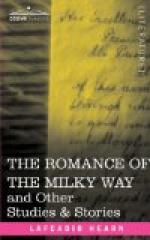* * * * *
The war has also suggested a variety of new designs for that charming object, the toko-niwa. Few of my readers know what a toko-niwa, or “alcove-garden,” is. It is a miniature garden—perhaps less than two feet square—contrived within an ornamental shallow basin of porcelain or other material, and placed in the alcove of a guest-room by way of decoration. You may see there a tiny pond; a streamlet crossed by humped bridges of Chinese pattern; dwarf trees forming a grove, and shading the model of a Shinto temple; imitations in baked clay of stone lanterns,—perhaps even the appearance of a hamlet of thatched cottages. If the toko-niwa be not too small, you may see real fish swimming in the pond, or a pet tortoise crawling among the rockwork. Sometimes the miniature garden represents H[=o]rai, and the palace of the Dragon-King.
Two new varieties have come into fashion. One is a model of Port Arthur, showing the harbor and the forts; and with the materials for the display there is sold a little map, showing how to place certain tiny battle-ships, representing the imprisoned and the investing fleets. The other toko-niwa represents a Korean or Chinese landscape, with hill ranges and rivers and woods; and the appearance of a battle is created by masses of toy soldiers—cavalry, infantry, and artillery—in all positions of attack and defense. Minute forts of baked clay, bristling with cannon about the size of small pins, occupy elevated positions. When properly arranged the effect is panoramic. The soldiers in the foreground are about an inch long; those a little farther away about half as long; and those upon the hills are no larger than flies.




